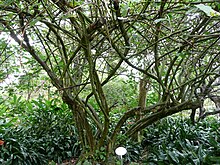Ficus palmata
| Ficus palmata | |
|---|---|

| |
| Scientific classification | |
| Kingdom: | Plantae |
| Clade: | Tracheophytes |
| Clade: | Angiosperms |
| Clade: | Eudicots |
| Clade: | Rosids |
| Order: | Rosales |
| Family: | Moraceae |
| Genus: | Ficus |
| Subgenus: | F. subg. Ficus |
| Species: | F. palmata
|
| Binomial name | |
| Ficus palmata | |
| Synonyms[1] | |
| |
Ficus palmata, the Punjab fig,[2] or "Bedu" is a plant in the family Moraceae. It is native to southern Egypt across to north-eastern tropical Africa and also the Arabian Peninsula. It is a shrub/tree with edible fruit.
Description[edit]
Ficus palmata grows as a shrub,[1] or tree,[3] growing up to 10 metres (30 ft) tall. The fruits, which turn purplish on maturing, measure up to 2 cm (1 in) long.[1] The flowers are greenish white.[3]
Taxonomy[edit]
It was first published by Peter Forsskål in Fl. Aegypt.-Arab. on page 179 in 1775.[1]
It is also known as the Wild Himalayan fig.[4]
Subspecies[edit]
There are 2 known subspecies;
Which has the synonyms of; Ficus virgata Roxb., Ficus caricoides Roxb., Ficus pseudocarica Miq. and Ficus urticifolia Roxb.
Distribution and habitat[edit]
Ficus palmata is native to north-eastern Africa: from Egypt south to Somalia, and to the Arabian Peninsula and Syria (the typical subspecies)[1] and to Asia: from the Arabian Peninsula and Iran east to India and the Himalayas,[4] (subspecies virgata).[6]
Its habitat, desert or dry shrubland including near villages in the Himalayas,[3] is at altitudes of 1,000–1,500 m (3,000–5,000 ft).[1]
Uses[edit]
In the Himalayan region, its fruit is widely sold and consumed.[3] The whole fruit, including the seeds are edible. The fruits are used in folk medicine to treat inflammation, pathogenic bacterial ailments and be used as an analgesic (Shi et al. 2014).[7]
References[edit]
- ^ a b c d e f g "Ficus palmata". Plants of the World Online. Royal Botanic Gardens, Kew. Retrieved 2 April 2021.
- ^ USDA, NRCS (n.d.). "Ficus palmata". The PLANTS Database (plants.usda.gov). Greensboro, North Carolina: National Plant Data Team. Retrieved 2 April 2021.
- ^ a b c d "Ficus palmata". Parmar, C. and Kaushal, M. K. 1982. Wild Fruits. Kalyani Publishers, New Delhi, India.
- ^ a b Bachheti, Archana; Deepti; Bachheti, Rakesh Kumar; Singh, Anjita; Zebeaman, Meseret; Hunde, Yilma; Husen, Azamal (2023). "Bioactive constituents and health promoting compounds of underutilized fruits of the northern Himalayas of India: a review". Food Production, Processing and Nutrition. 5 (24).
- ^ "Ficus palmata subsp. palmata | Plants of the World Online | Kew Science". Plants of the World Online. Retrieved 25 October 2023.
- ^ a b "Ficus palmata subsp. virgata". Plants of the World Online. Royal Botanic Gardens, Kew. Retrieved 7 April 2021.
- ^ Shi, Y.; Hu, H.; Xu, Y.; Liu, A. (2014). "An ethnobotanical study of the less known wild edible figs (genus Ficus) native to Xishuangbanna, Southwest China". Journal of Ethnobiology and Ethnomedicine. 10 (1): 1–11.
